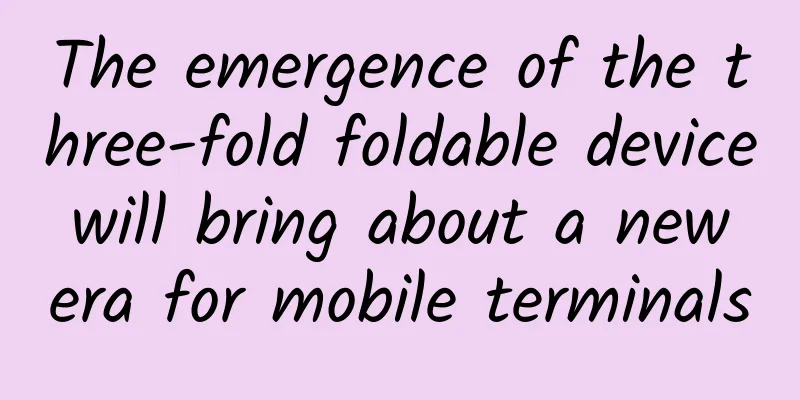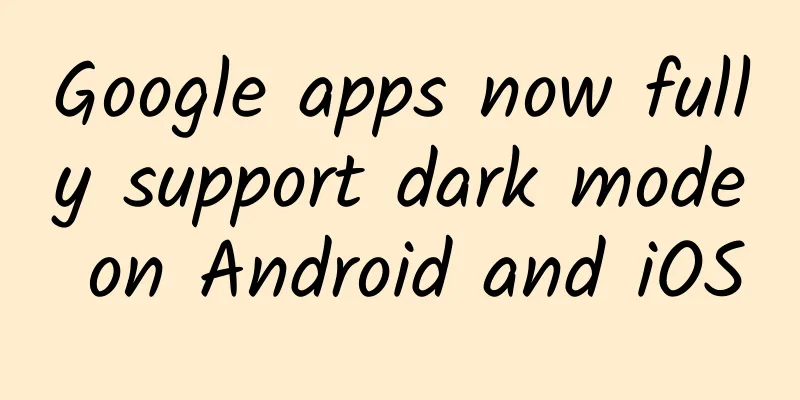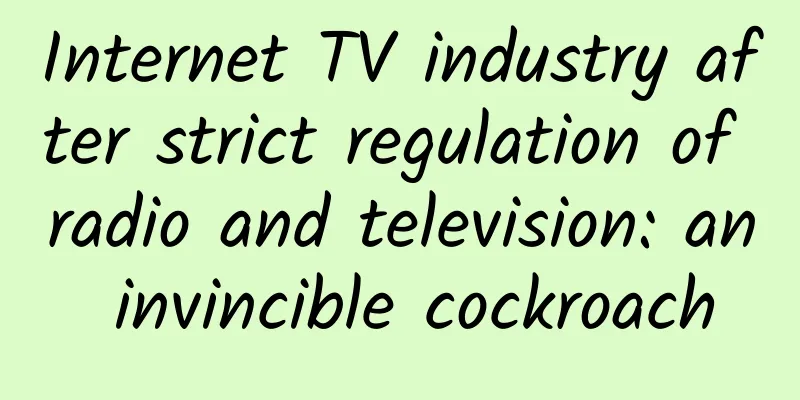The emergence of the three-fold foldable device will bring about a new era for mobile terminals

|
Import: The technical deep waters of folding screens may be welcoming a "blockbuster bomb". In March this year, Huawei announced a patent for a "folding screen device". The three-fold design exposed in the information started the warm-up of the world's first commercial three-fold screen mobile phone; on July 15, Huawei's executive director, chairman of the Terminal BG, and chairman of the Intelligent Automotive Solutions BU Yu Chengdong revealed in the "Walking with Hui" live broadcast that this is a folding screen that "others can think of but cannot make", which has triggered speculation and discussion across the entire network; in August, a number of digital bloggers and Huawei dealers broke the news that Huawei's first three-fold screen mobile phone is expected to be released in the second half of the year at the earliest. If all these speculations and rumors come true, Huawei will open up a new folding series. For the current market, which only has three folding forms: vertical folding, external folding, and internal folding, it will be the birth of a new species. However, the impact of this increase in the number of folds is not limited to this, because it not only revolutionizes the traditional folding screen paradigm that has been developed for 5 years, but also opens a new era of "everything is displayed" for mobile terminals. If you trace the development history of mobile terminals, you will find that this is a process of change in the way people interact with information. Whether it is the ancient knotted cords and pigeons, or the pagers that became popular in the 1980s and 1990s and have become a memory of a generation as the communication methods of modern society develop, or the full-screen era opened by Apple's iPhone X in 2017 - a small mobile phone screen has long become an important medium for people to interact with the world. Especially in an era of information explosion in the digital world, how to improve the efficiency of this information interaction has become a question for the changes in screens. In fact, this is why flexible display technology represented by folding screens is needed. Since physicist Nicholas Seldon invented electronic paper in 1974, flexible display has been invested in more than a decade before the birth of folding screen mobile phones. A market research institution once predicted that the compound growth rate of flexible screen investment will be 21% from 2019 to 2022, and the global flexible screen market space will reach US$51.1 billion in 2022. The evolution of folding that "starts with mobile phones and ends with everything" may be just like this . Once upon a time, folding screens were launched as smartphones, but you have to know that the essence of flexible display is the continuous advancement of screen technology. Since the birth of the first digital screen, humans have been pursuing a clearer technical route to truly restore human eyes. However, no matter how "clear" the picture is, the information limited to the "screen" is always a narrowing of human visual space. Therefore, there is a folding screen that pursues a larger screen, displays more information, and brings more interactions. Since the beginning of the first year of folding screens in 2019, with the advancement of industrial chain technology and the education of market users, folding screens have already made the leap from the early stage to the era of mainstream phones. The thinness of the body, the crease of the screen, and the reliability have all been greatly improved under the innovation of folding screen players led by Huawei. But in addition to solving all the user pain points, how can the folding screen outline the next future? This has become the proposition of the next stage of this industry that has experienced five years of rapid growth. Is it the rumored triple folding screen? If so, why did it happen to be Huawei? 1. Why is Huawei the one to innovate what others can think of but cannot do? As a new species of mobile terminal, the tri-fold screen represents the evolution and integration of screen display. From Motorola's big brother in 1983, to IBM's touch screen in 1994, to Samsung's 5.3-inch Galaxy Note in 2011, to the full-screen era led by iPhone X in 2017, to the era of large folding phones opened by Huawei Mate X in 2019, you will find that smartphones, as an extension of human senses, need larger screens to create the "non-presence sense" function, thereby bringing more efficient sensory interaction. At the same time, if you look at the changes in PCs and tablets, you will find that laptops are also becoming thinner and lighter. Since Intel started the thin and light revolution in 2003, the MacBook Air was first released from the envelope in Jobs' hands, and then the first generation of iPad was released in 2010. In 2023, MatePad started the dual iteration of large screen and thinness. Tablet PCs that meet the diverse needs of mobile office need to become thinner and lighter to occupy more scenarios and time of users. In a digital age where new productivity is constantly emerging and audio-visual entertainment scenes are becoming more diverse, mobile phone screens are getting bigger, while PCs and tablets are getting thinner. This is because large screens represent productivity efficiency and can display and interact with more information at the same time. Finding a large screen that is portable and can even be held in one hand means finding a perfect balance between large screen efficiency and portability. In the past, mature mobile phone forms represented by large folding are enough to predict that multi-folding may become a new beginning of the mobile terminal display revolution. In fact, at major technology exhibitions such as MWC and CES in the past, the three-fold screen has become a folding technology for mobile phone manufacturers to show off their muscles. However, in today's era when folding screen mobile phones have already made great strides towards becoming the main machine, blindly drawing pie is no longer the key for market pioneers to adapt to the development laws of mobile terminals. As Richard Yu once said, " Huawei is committed to doing things that others can't think of, or things that others can think of but can't do, or even things that they dare not think of ." It is this value that has made Huawei the first mobile phone manufacturer in the industry to invest in three folding forms, with enough technical confidence to refuse to "draw cakes". Now, Richard Yu revealed in the live broadcast that the next generation of Huawei's folding screen, which is about to be released, has been developed for 5 years, making it difficult for the outside world not to speculate that Huawei has taken the lead in realizing the mass production of the world's first three-folding screen from concept machine to commercial machine. One question that cannot be avoided is: Why can it only be Huawei? First of all, it is the long-termism of being an industry disruptor . The next-generation folding screen, which has been developed for 5 years, means that Huawei may have started the research and development layout of tri-fold technology almost at the same time as it entered the folding screen track. At a time when Apple's folding iPhone has been postponed several times to 2026 and the global smartphone industry is still suffering from the impact of the economic cycle, Huawei's tri-folding screen is enough to be a bet that requires strategic vision and long-termism. Compared with the sea of machines tactics of mobile phone manufacturers, technological innovation is actually a long-term track. It requires years of resource investment and goal adherence regardless of cost to achieve success. In the context of severe macroeconomic conditions and external sanctions, Huawei is still not affected by external cycles. Five years ago, it made a long-term layout of the three-fold screen as a high-profit support for the entire terminal business. It can be said that it is the strength feedback brought by this long-termism that has created the courage to open up the three-fold. Secondly, it is the deep cultivation and accumulation of folding screen technology. You should know that Huawei is one of the few mobile phone manufacturers in the market that has invested in three folding forms. Since the first Mate X came out in 2019, Huawei has been bringing new experiences to users in different folding screen product forms. Today's folding screen product line has covered three full forms: horizontal folding inward, horizontal folding outward, and vertical folding. This all-round product layout has brought Huawei mature experience in hinges, folding screens, RF chips, and software ecology, enabling it to build a technical moat in the field of folding screens. According to the iResearch report, the foldable screen mobile phone market in the first half of 2024 will present a "one pole and many strong" competition pattern. And this "one pole" is Huawei, which leads with a market share of 42%. Huawei leads and occupies half of the market, especially in the ultra-high-end market of more than 10,000 yuan, accounting for 67%. Perhaps Huawei, which leads in all aspects, has enough industry accumulation to achieve the leap of industry innovation paradigm such as the three-fold screen. iResearch pointed out in the "2024 Foldable Screen Mobile Phone Market and Consumption Trend Research Report": Although the current foldable screen mobile phones are still focused on high-end business people, this does not mean that the ceiling of this track is limited. Because looking at the development of other consumer electronics categories, they are all transmitted step by step from high-end positioning, starting from a single scene to multi-scene linkage. In this process, as the boundaries between different terminals gradually disappear, the three-fold screen has formed an all-round and borderless future terminal because it covers more scenes and needs. In other words, if Huawei successfully launches the three-fold screen, mobile terminals will launch a new screen revolution. On the one hand, with the mature mass production of tri-fold technology as a sign, the folding screen field will open up a new competitive track. Because the tri-fold technology means that the two different terminal experiences of tablet PCs and smartphones have undergone a historic fusion, a new "mobile large screen" species has emerged, rewriting the industry's innovation path. On the other hand, the tri-fold also means that the folding screen mobile phone has ushered in a technological upgrade, and the productivity work and entertainment scenes are further integrated into a foldable screen. The digital life of modern human society will usher in new imagination space. 2. In the era of “everything is displayed”, Huawei’s 30% foldable smartphone may start a display revolution in mobile terminals If Apple Vision Pro, as a virtual reality device, has opened the door to spatial computing, and Tesla Model Y has led the way in the intelligent future of automotive terminals, then the upcoming Huawei Trifold will also start a new round of display revolution in mobile phone terminals due to its revolutionary folding form. More than a decade ago, Steve Jobs, who believed that larger screens were stupid, once said that 3.5 inches was the perfect golden size. This standard is defined as the thumb being able to touch at least 90% of the screen area when operated with one hand. However, as the amount of information humans are exposed to grows exponentially, large-screen mobile phones have not only become the mainstream of the era, but have also ushered in their own full-screen era. From 3.5 to 4 inches, to 4.3, 5, 5.5, 6.1 and even 6.7 inches, to the current largest 8-inch folding screen mobile phone, mobile phone screens have begun to break through the human handheld limit step by step. In fact, as the screen size gets larger and larger, the functional value carried by the mobile phone is becoming more and more important. Especially in the current outbreak window of AI-led intelligent terminal transformation, user needs and scenarios have been greatly released. In this sense, the three-fold screen, as a revolution in screen display technology, can be said to be a preparation for the arrival of artificial intelligence in the infrastructure hardware layer. From more immersive gaming experiences to film and television entertainment content that replaces tablets and computers; from forms, documents, and image processing that meet productivity needs to control terminals for electronic devices such as whole-house intelligence - rather than saying that the three-fold screen is a multi-terminal integration of computers, tablets, and mobile phones, it is better to think that the three-fold screen has opened up an integrated era of human digital life. Through a foldable and portable screen, it can meet the needs of various scenarios such as human life and work. This integrated development trend will in turn establish the super terminal status of the three-fold screen. For the consumer electronics industry, the maturity of tri-fold technology has also ushered in a new innovation anchor. Just like the iPhone to Apple and the Model Y to Tesla, the folding screen industry chain will be further improved under the feedback of terminal demand, and it will also drive more software manufacturers to join and jointly create a new folding screen ecosystem. From this perspective, the tri-fold screen may serve as an industry lever that can pry the power of innovation in the entire ecosystem. After five years of rapid growth, the folding screen track has become mature in terms of both cost and technology. For most Chinese mobile phone manufacturers, this may be the segment track that is easiest to overtake Apple. Because after overseas mobile phone manufacturers represented by Apple have firmly occupied the leading position in the global high-end mobile phone market for many years, Huawei, which has already assumed more innovation responsibilities, has opened up the next future for the industry, just like the folding screen track five years ago. From double folding to triple folding, and then from triple folding to N folding, with the arrival of more diverse folding forms, Huawei has taken the lead in starting the revolution of mobile terminals. The future of this change lies in the fact that the changes in human lifestyles and work patterns are no longer centered around mobile terminals such as mobile phones or computers, but return to a portable, recreated screen. When the media carriers for human interaction with information have achieved a leap from language to books and then to screens, along with the fourth industrial revolution with 5G and IoT as the core, there is also a terminal future where "everything is displayed." (Source: 36Kr) As a winner of Toutiao's Qingyun Plan and Baijiahao's Bai+ Plan, the 2019 Baidu Digital Author of the Year, the Baijiahao's Most Popular Author in the Technology Field, the 2019 Sogou Technology and Culture Author, and the 2021 Baijiahao Quarterly Influential Creator, he has won many awards, including the 2013 Sohu Best Industry Media Person, the 2015 China New Media Entrepreneurship Competition Beijing Third Place, the 2015 Guangmang Experience Award, the 2015 China New Media Entrepreneurship Competition Finals Third Place, and the 2018 Baidu Dynamic Annual Powerful Celebrity. |
<<: What is the best tool for looking up words? A comprehensive review of Youdao Dictionary Pen
Recommend
4G is still growing, but 5G is a bit embarrassing: Has the promised trend of changing phones come to an end?
Last week, the Ministry of Industry and Informati...
These Chinese scientists have built a photonic city on a chip the size of a little fingernail!
Produced by: Science Popularization China Author:...
Another Tesla accident: Model X collided with Porsche and other vehicles in Chengdu
Recently, there have been many traffic accidents ...
Can there be turbulence on sunny days? How does weather affect aviation?
What is the outdoor temperature? Is it windy, rai...
Why are there more and more popular apps, but their popularity is getting shorter and shorter?
Changba, Moman Camera, Crazy Guess Picture, Face ...
Data operation case: information flow feeds product optimization
The author of this article leads everyone to have...
Universal data analysis rules, master the essence of analytical thinking, and be proficient in multiple types of business scenarios
Universal data analysis rules, master the essence ...
"Little Me" is a hit! About the cerebral palsy in the play: I'm not stupid, just a little slow
Recently, the movie "Little Me" is bein...
8 types of operation tools to help you become an operation master
In the era of big data and AI , even pigs can fly...
What is the difference between server hosting and virtual hosting?
The advantages of server hosting are that users h...
The era is over! Netizens say that Symbian phones can no longer log in to QQ/WeChat
From the arcade N73, to the T9 flagship N95, to t...
Weibo Fans Advertising Optimization Tips!
I believe most advertisers are very familiar with...
JD.com builds global distribution channels for smart hardware, expands overseas business and builds a large ecosystem
Just as overseas companies such as Apple and Goog...
All you need to create high-conversion information flow promotion ideas is these few tricks!
What kind of creative has a high click-through ra...
10 Observations on E-commerce Marketing in 2020
This article, which contains 10 observations for ...









